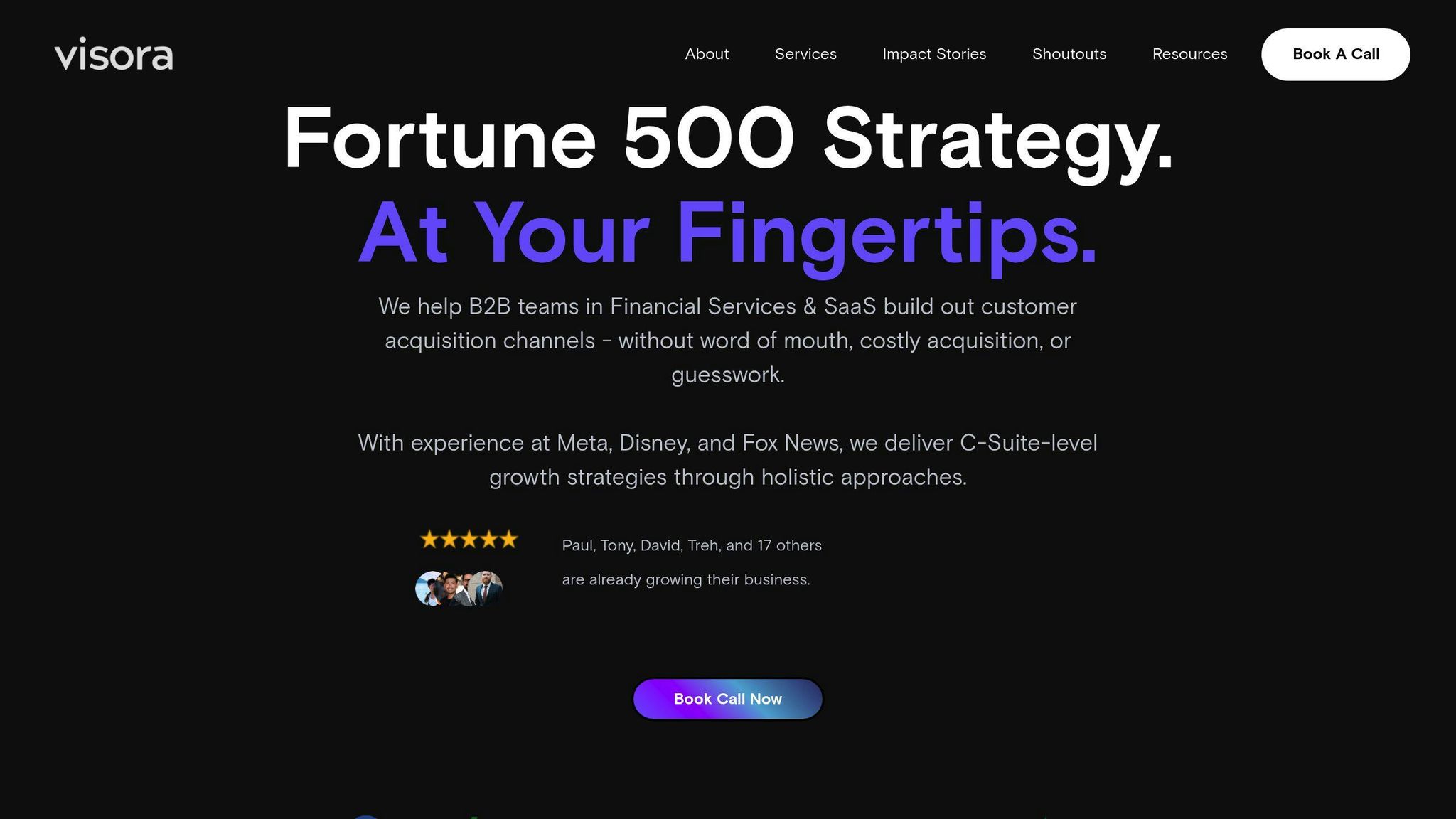
B2B onboarding in fintech needs to be fast, secure, and personalized. Why? Because 64% of clients prefer tailored onboarding, and delays can lead to 68% abandonment rates. The right approach can reduce onboarding time from months to days, improve satisfaction, and ensure compliance.
| Method | Time-to-Onboard | Customer Satisfaction | Security | Cost Efficiency |
|---|---|---|---|---|
| AI-Powered Tools | 1-3 days | 82% | High | Medium-High |
| Self-Service Systems | 3-7 days | 76% | Medium-High | High |
| Manual Processing | 14-30 days | 65% | High | Low |
For fintech firms, balancing speed, security, and client experience is key. Small firms benefit from self-service systems, medium firms thrive with hybrid models, and large enterprises excel with advanced AI tools. Read on for detailed strategies and tools to optimize your onboarding process.

Visora blends advanced CRM systems with customized onboarding journeys to simplify technical integration while ensuring security standards are met.
This method caters to the increasing need for customized, tech-focused onboarding in fintech. Here’s how their core elements align with industry needs:
| Component | Function | Impact on Onboarding |
|---|---|---|
| Data-Driven Marketing | Analyzes client behavior and segments | Creates onboarding paths tailored to client needs |
| Advanced CRM Integration | Manages workflows automatically | Minimizes manual tasks and speeds up setup |
| Personalized Sales Funnels | Maps out custom client journeys | Improves engagement and adoption rates |
Visora's go-to-market (GTM) consulting services are designed to refine fintech onboarding through technology-driven customization. They prioritize understanding each client’s specific needs before automating processes.
What sets Visora apart is their emphasis on omni-channel integration. By leveraging multiple communication points, they ensure smooth interactions and automate repetitive tasks.
To maintain security and compliance, Visora employs:
Their Trifecta Program combines GTM strategy with automated sales tools to deliver an onboarding experience that balances technical efficiency with user satisfaction. This comprehensive approach ensures smooth and effective client onboarding.
While Visora’s expertise lies in personalized, data-focused strategies, advancements like AI are reshaping how onboarding scales to meet larger demands.
AI is transforming fintech onboarding by automating verification processes and tailoring them to fit individual client needs. This approach allows fintech companies to grow while maintaining both trust and customer satisfaction.
Modern AI onboarding platforms focus on three main areas:
| Capability | Function | Business Impact |
|---|---|---|
| Identity Verification | Automated KYC and biometric authentication | Speeds up verification by removing the need for manual reviews |
| Document Processing | Smart form filling and data extraction | Reduces paperwork and minimizes errors in data entry |
| Workflow Automation | Real-time workflow adjustments | Maintains efficiency while ensuring compliance |
Companies like Payline Data and Mosaic are already using AI to streamline onboarding, cutting timelines from months to weeks. For example, Payline Data uses automated document handling and smart routing to set up clients quickly without compromising on security.
To get the most out of AI onboarding tools, fintech firms should:
The real challenge is balancing automation with a personal touch. By analyzing client behavior, AI systems can predict needs and adapt processes, delivering a smoother onboarding experience without sacrificing security.
For B2B fintech firms, AI onboarding tools reduce manual tasks and provide insights into client preferences. This data-driven approach not only improves the onboarding process but also ensures compliance and security standards are upheld.
While AI boosts efficiency and scalability, self-service options give clients more control over their onboarding journey, enhancing the overall user experience.
Self-service systems give clients more control while keeping processes efficient. With 63% of fintech customers expecting mobile-first onboarding and 68% abandoning applications due to friction, these systems have become crucial.
Here are the three main components of self-service systems:
| Component | Purpose | Impact |
|---|---|---|
| Document Management | Centralized storage and automated processing | Cuts manual paperwork by up to 90% |
| Identity Verification | One-click authentication via social platforms | Speeds up the verification process |
| Progress Tracking | Real-time visibility into onboarding status | Boosts client engagement |
To succeed, self-service systems must balance automation with strong security. Companies like Payline Data and Mosaic have shown how integrated verification tools and milestone-based tracking can reduce onboarding times from months to weeks.
For a smooth client experience, these systems should focus on:
Self-service systems not only provide clients with more control but also help fintech firms merge automation, personalization, and efficiency effectively.
Choosing the right onboarding method depends on how well it aligns with client needs and business goals. Here's a quick comparison:
| Onboarding Method | Time-to-Onboard | Customer Satisfaction | Security Level | Cost Efficiency |
|---|---|---|---|---|
| AI-Powered Tools | 1-3 days | 82% | High | Medium-High |
| Self-Service Systems | 3-7 days | 76% | Medium-High | High |
| Traditional Manual | 14-30 days | 65% | High | Low |
AI-powered tools stand out for their speed and security, reducing onboarding times by up to 90%. With 64% of consumers favoring personalized onboarding experiences, companies like Mosaic have shifted to hybrid models that blend automation with tailored support.
"Customer onboarding is critical to your success... It's a great way to show quick value." - Abhishek Vora, Head of Customer Success at Mosaic
The numbers speak for themselves: traditional methods come with a 68% abandonment rate, emphasizing the importance of user-friendly, secure systems. Mosaic’s hybrid approach, combining automation with human touchpoints, brought onboarding timelines down from six months to just weeks - all while keeping satisfaction levels high.
For fintech firms, the key is to balance speed, personalization, and compliance. Often, a hybrid model combining the strengths of these methods offers the most effective solution.
Deciding on the best onboarding approach for fintech B2B companies largely depends on the size of the organization and what clients expect. The challenge is to strike a balance between speed, security, and customization.
For smaller fintech firms, a combination of self-service options and basic AI tools can provide an affordable solution. These systems typically complete onboarding in 3-7 days, with a satisfaction rate of 76%. Medium-sized companies see better results with hybrid models that mix AI and some manual processes, cutting onboarding time to 2-5 days and boosting satisfaction to 82%. For large enterprises, the best results come from advanced AI systems paired with dedicated support teams, achieving onboarding in just 1-3 days and satisfaction rates exceeding 85%.
| Company Size | Strategy | Performance |
|---|---|---|
| Small (<50) | Self-service + Basic AI | Onboarding: 3-7 days, Satisfaction: 76% |
| Medium (50-250) | Hybrid AI + Limited Manual | Onboarding: 2-5 days, Satisfaction: 82% |
| Large (250+) | Comprehensive AI + Dedicated Support | Onboarding: 1-3 days, Satisfaction: 85%+ |
Looking ahead, fintech onboarding systems need to keep pace with regulatory updates while ensuring smooth and user-friendly experiences. Priorities include improving compliance processes, leveraging data for more personalized interactions, supporting multiple devices, and implementing strong security measures to protect sensitive financial data.
Future-ready systems must seamlessly integrate these elements, offering efficient and secure onboarding experiences that meet both regulatory demands and user expectations.